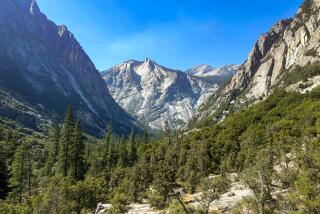Utah, alive with color
- Share via
St. George, Utah — UTAH demands patience. In the southwestern corner of this state, the roads suddenly narrow, rub up against cliffs, cut through rock. And then, just as unexpectedly, they open up to run wide and straight through valleys.
Starting eight miles north of St. George, Utah 9 heads east between mountain ranges and through grassy fields to Zion National Park. Late fall, after the crowds thin but before snow falls, can be a magical time to visit. The weather is temperate (summer days can heat up to over 100 degrees), and deep blue autumn skies set off the canyon’s red sandstone.
Zion Canyon Scenic Drive, which goes north from Utah 9 into the heart of the park, is closed to cars until November. Shuttles run people from the Visitors Center to popular spots: the Emerald Pools, Weeping Rock, the Temple of Sinawava. The water-sculpted rocks of this so impressed 19th century Mormon pioneers that they named the canyon “Little Zion” after the heavenly city. Utah 9 climbs in adrenaline-producing switchbacks. You can catch your breath at the car pullouts, but the stunning vistas will just take it away again.
Once outside the park, Utah 9 connects to U.S. 89 and Utah 14, which work their way through Dixie National Forest, past the log cabins of quaint Duck Creek Village, to Cedar Breaks National Monument. The natural rock amphitheater -- about 9 square miles and 2,000 feet deep -- is wrapped in bright colors. The Paiutes called it “the circle of painted cliffs.” And indeed, it is a work of art: a gallery of spires, natural arches and ledges carved by snow, wind, rain and patience.
More to Read
Sign up for The Wild
We’ll help you find the best places to hike, bike and run, as well as the perfect silent spots for meditation and yoga.
You may occasionally receive promotional content from the Los Angeles Times.






